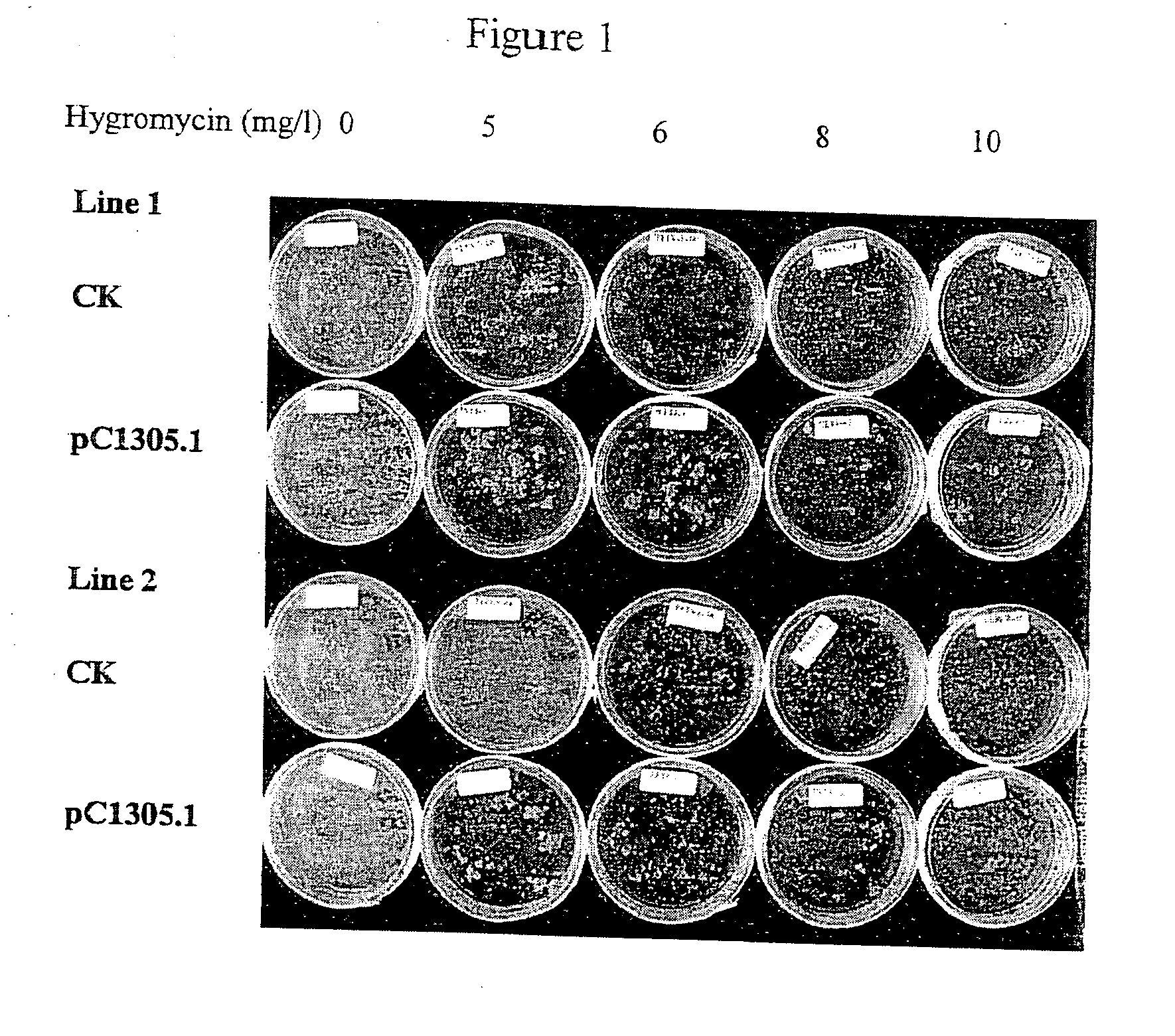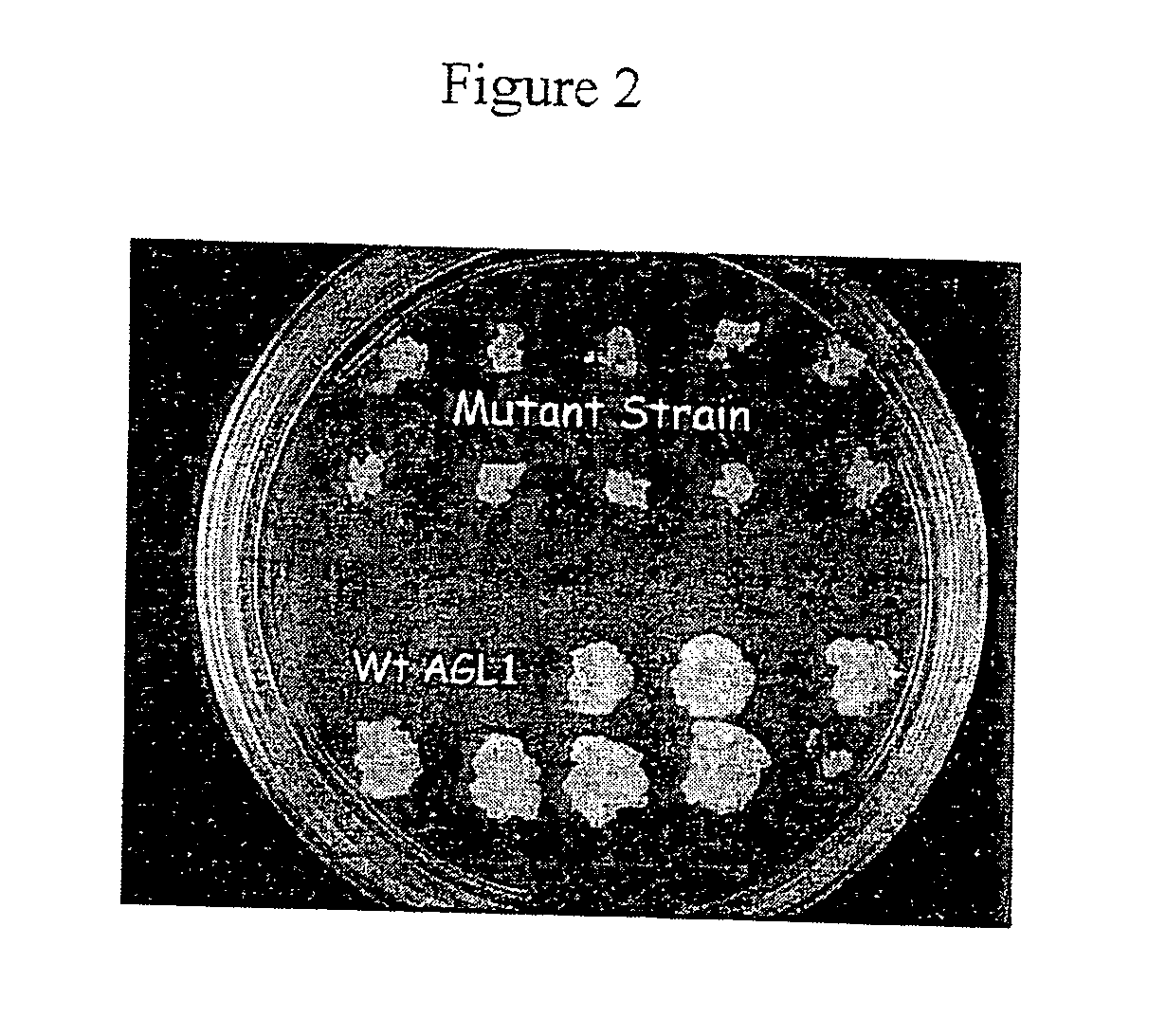media compositions, selection methods and agrobacterium strains for transformation of plants
a technology of agrobacterium and media composition, applied in the field of transgenic plants, can solve the problems of increasing the pressure on food production, worsening the green house effect, and dwindling fossil fuel supply in the world, and achieve the effect of improving the efficiency of agrobacterium-mediated transformation
- Summary
- Abstract
- Description
- Claims
- Application Information
AI Technical Summary
Benefits of technology
Problems solved by technology
Method used
Image
Examples
example 1
Media Formulations
[0076]J20P: NH4NO3-free MS salts, MS vitamins, 20 g / l sucrose, 50 g / l PEG 8000, 0.5 g / l glutamine, 0.25 g / l asparagine, 0.2 mg / l 2,4-D sodium salt, pH 5.8
[0077]IM (Chilton et al., 1974; de Groot et al., 1998): 2.05 g / l K2HPO4, 1.45 g / l KH2PO4, 0.6 g / l MgSO4-7H2O, 0.5 g / l (NH4)2SO4, 0.5 g / l NH4NO3, 0.01 g / l CaCl2, 0.5 mg / l ZnSO4-7H2O, 0.5 mg / l CuSO4-5H2O, 0.5 mg / l H3BO3, 0.5 mg / l MnSO4—H2O, 0.5 mg / l NaMbO4-2H2O, 1 mg / l FeSO4, 0.5% glycerol, 0.5 g / l 2-[N-morpholino]ethanesulfonic acid (MES), 0-100 μM acetosyringone, 2 g / l glucose, pH 5.7-5.8
[0078]JIM2: IM medium plus: B5 vitamins, 2 mg / l 2,4-D, 1-50 diphenylene iodonium (DPI).
[0079]JIM2 solid: JIM2 with 2 g / l phytagel.
[0080]JIM2H: JIM2 medium plus 0.3 g / l histidine.
[0081]JIM2H solid (for co-culture): JIM2H with 2 g / l phytagel.
[0082]Bd2: Gamborg B5 salts, B5 vitamins, 30 g / l sucrose, 2.2 g / l phytagel, 2 mg / l 2,4-D sodium salt, pH5.8.
[0083]DGA: NH4NO3-free MS salt, Gamborg B5 vitamins, 30 WI sucrose, 2.4 g / l phytagel, ...
example 2
Co-Culture of Embryogenic Calli with Agrobacterium
[0088]Embryogenic cell lines, for example, JS4 cell line, which was derived from a zygotic embryo of an Indonesian Jatropha curcas collection, were subcultured every week by transferring about 3 g of the cell mass to 20 ml J20P medium. 3-5 days after subculture, the embryogenic calli cell mass was collected.
[0089]Co-culture plates were made by pouring about 30 ml JIM2H solid medium to each 90 mm Petri dish. Alternatively, 3-4 sheets of cellulose filter paper can be soaked with JIM2H liquid medium before placing into a 90 mm Petri dish. One sheet of 82 mm Hybond N membrane was over-laid to the medium-soaked cellulose filter paper or solid JIM2H medium. About 0.75 g embryogenic calli was mixed with 200 ul Agrobacterium cells on the membrane. After one hour incubation at room temperature, excess liquid medium containing the Agrobacterium cells was removed. The plates were capped, sealed with 3M tape and incubated at 24° C. with dim lig...
example 3
Preparation of Agrobacterium Cultures
[0090]Fresh colonies of AGL2 or AGL3 harboring pCambia1305.1 were inoculated into 30 ml LB medium that had been supplemented with 25 mg / l rifampicin and 50 mg / l kanamycin. Cells were cultured at 28° C., 200-230 RPM until OD600 reached 0.8-2.0. The culture was diluted to 0.3 OD600 units with LB medium with appropriate antibiotics and incubated in the same condition for about 2-3 hr at 28° C. until about 0.6 OD600 unit. 25 ml of the Agrobacterium culture were transferred to a 50 ml Falcon tube and the cells were spun down at 3500 RCF, 15° C. for 20 min in a benchtop centrifuge with a swing-out rotor. The LB medium was removed and the pellet was resuspended in 25 ml JIM2H medium. The cells were allowed to induced at room temperature with no shaking for about 2 hours and the Agrobacterium preparation was adjusted to about 0.5 OD600 using the same medium.
[0091]For transformants of wt AGL1 strain, the cells were cultured in the Agrobacterium MinAB medi...
PUM
| Property | Measurement | Unit |
|---|---|---|
| temperature | aaaaa | aaaaa |
| temperature | aaaaa | aaaaa |
| pH | aaaaa | aaaaa |
Abstract
Description
Claims
Application Information
 Login to View More
Login to View More - R&D
- Intellectual Property
- Life Sciences
- Materials
- Tech Scout
- Unparalleled Data Quality
- Higher Quality Content
- 60% Fewer Hallucinations
Browse by: Latest US Patents, China's latest patents, Technical Efficacy Thesaurus, Application Domain, Technology Topic, Popular Technical Reports.
© 2025 PatSnap. All rights reserved.Legal|Privacy policy|Modern Slavery Act Transparency Statement|Sitemap|About US| Contact US: help@patsnap.com



